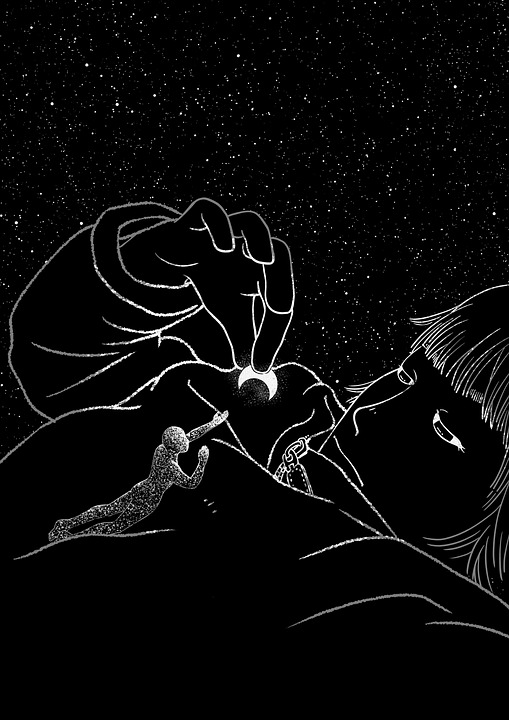
How you’re feeling is not your fault. How your nervous system is acting doesn’t mean anything about you. It’s not a mistake. Not a wrongdoing on your part. Not a sign of failure.
The narrative of:
If only I had done something differently, I wouldn’t be like this. If I was “normal” then this wouldn’t be happening. Other people don’t experience this. This must mean there’s something wrong with me.
Is a false, self-deprecating conditioned narrative from a culture that demonizes and has great disdain for dark emotion – pretending that this darkness doesn’t exist.
Psychologists call changing what you think about what you feel “cognitive restructuring” or “reframing.” For instance, thinking “I’m weak” when you feel sad or scared can be reframed as “I’m strong and courageous enough to let myself feel sad or scared.” In re-visioning and reframing the power of grief, fear, and despair we come to think about them not as obstacles or enemies but as guides to spiritual transformation. This kind of affirmation is an essential foundation for trusting emotional energy and using it wisely.
Miriam Greenspan, Healing Through Dark Emotions
Tapping into this darkness and being in tune with the delicate tapestry of this emotional underworld means giving space and permission to the hurt little ones within. Their right to be here. The right for the embryonic pre-communication vulnerable ones to move through us, to show their faces.
Their repression into shadow need not be the norm anymore. They can come into the light and feel into their right to exist, their inherent right to be here. And part of that is acknowledging and feeling into their conditioned and believed sense of wrongness and the shame that comes with that. The shame of the dark emotion, the shame of intense vulnerability being labeled as weakness. And the recoiling nature of that shame.
Being in the dark for so long can cause an aversion to the light. So a recoiling can happen, a recoiling of ‘it’s not safe enough out here, let’s go back into the dark’. But great patience is needed here. Great self-compassion. To acknowledge inwardly that it’s no small feat to be in tune with the underworld. To learn to let it move through. To feel the aching vulnerability of a baby who feels totally, utterly and violently overwhelmed by 3D reality is no small thing.
And the facade of ‘normal’ out here in the world – especially in relating with others – is a great trigger point for any vulnerable, scared, hurt parts of us to feel outrageously out of place and recoil. The “normal” surfacey interactions of everyday life can feel even callous for those of us who are courageous enough and willing enough to unearth the underworld of dark emotion and live on the edge of vulnerability, precision and open-heartedness.
The ‘normal’ can feel painful to us. And it’s important to name that and not make that wrong. That ‘normal’ is fucking painful to us and this truth is our new normal. The truth of acknowledging and recognizing the facade of normal for what it is. No matter how convincing it looks.
A facade is a front. It’s not real. It’s aesthetics. It’s reality is lesser than the reality of the underworld of dark emotion. Meaning that it’s unreal. Even though it might not look like it or even feel like it sometimes. But that whole surface level of relating is sitting on top of suppressed dark emotions. And that’s where we learn that darkness is wrong. That’s where we learn, I’m crazy (for feeling this, for seeing this, for sensing this). We learn it and imbibe it by taking in the facade of normal to be realer than the underworld of dark emotions.
Making the darkness right needs to happen first before the darkness can turn into light. Which is ultimately not something we do but an inner alchemy that happens of it’s own accord. We can facilitate this process by making the darkness right; recognizing and acknowledging from our full humanness and full being-ness that the underworld of dark emotions is real. For us. And is not just worthy of our loving attention but more than that if we are to function and relate in a healthy and wholesome way, we must tend to this underworld wholeheartedly. Otherwise it will leak out in ways beyond our control or even awareness.
In making the darkness right, an inner permission slip is given to unearth the hidden, shadowy, latent tendencies of that underworld. Bringing it up to the light to be seen, felt and digested. In the rightness of the darkness, we start to see through the facade of normal functioning and the facade of normal relating. And in seeing through this facade, our ability to function and relate in a more real and grounded way starts to reveal itself to us.
When we are no longer participating in the facade nor believing the facade, our attention can be freed up to turn around from the outward appearances of ‘normality’ to the inward reality of what’s being unearthed. The vulnerability, the fear, the shakiness, the aching become our allies. And a new learning happens where we start to understand and listen to the cues of our inner world. The ways in which it is constantly communicating to us through the body with information we need to pay attention to.
Information like:
This is too much for me right now. I need to set a boundary here. I need to rest now. I don’t feel safe here. My nervous system is overwhelmed. This interaction doesn’t feel true for me. This person is standing too close to me. I need to remove myself from this situation.
Or.
I love this. This feels natural to me. I want to do more of this. This space is safe. I feel nurtured.
Our ability to inwardly listen to these cues is heightened when we can genuinely dis-engage from the facade of normal and see it for what it is. This is like unplugging from a machine of conditioning with a motor so loud – you can hardly hear yourself. Unplugging this machine is a whole dance unto itself of standing your ground. And bringing kindness to the places that wobble. The places that still believe the facade of normal and take it at face value.
The wobbly places are where we carry trauma. Trauma can be as simple as an inner sense of disbelief at how convincing the facade of normal appears to be. All the little things we took for granted to be natural and authentic reveal themselves to be a complete lie, a fabrication, even acting.
This comes as a shock to the system – one in need of full digestion. Because it reveals to us a whole thread of information that has been unconscious to us in the past. That in our innocence and in our conditioning, we were taught to believe the lie and accept it for what it is. And there can be a lot of rage and even despair unearthed within us – just from that one piece.
The energy of the dark emotions brings us information about the self and the world; about the past, present, or future; about the inner and outer worlds and the connections between them. The information we get alerts us to be attentive to something important and guides us to transformational change.
Miriam Greenspan
